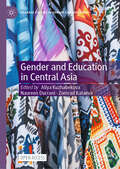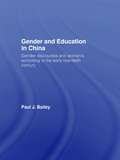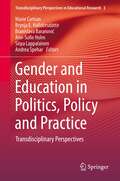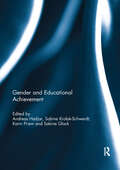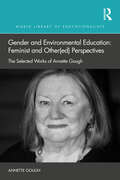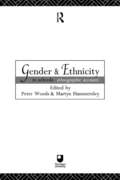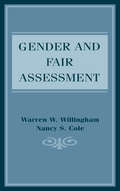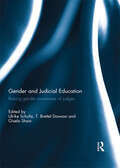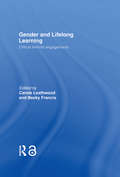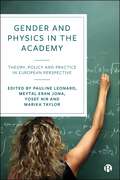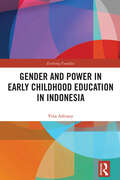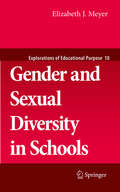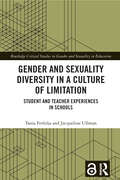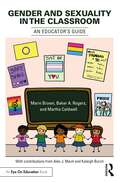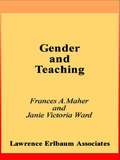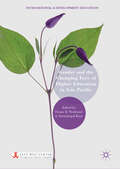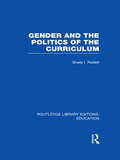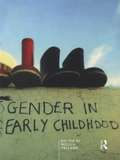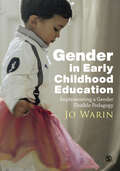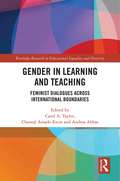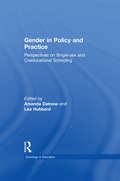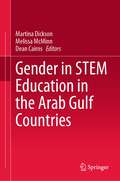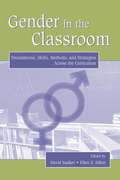- Table View
- List View
Gender and Education in Central Asia (Palgrave Studies in Gender and Education)
by Naureen Durrani Aliya Kuzhabekova Zumrad KataevaThis open access book brings together established and emerging scholars to explore policies, statistical trends and representative research on gender equity across post-Soviet Central Asia. The book provides an overview of policy development in the promotion of gender equity, a comparative summary of changes in gender equity indicators at various levels of education, and examples of current research on an array of issues relating to gender equity across the region. The chapters present a broad picture which will be relevant to scholars of educational reform, comparative education policy, international development and gender issues.
Gender and Education in China: Gender Discourses and Women's Schooling in the Early Twentieth Century (Routledge Contemporary China Series #Vol. 15)
by Paul J. BaileyGender and Education in China analyzes the significance, impact and nature of women's public education in China from its beginnings at the turn of the twentieth century. Educational change was an integral aspect of the early twentieth century state-building and modernizing reforms implemented by the Qing dynasty as a means of strengthening the foundations of dynastic rule and reinvigorating China's economy and society to ward off the threat of foreign imperialism. A significant feature of educational change during this period was the emergence of official and non-official schools for girls. Using primary evidence such as official documents, newspapers and journals, Paul Bailey analyzes the different rationales for women's education provided by officials, educators and reformers, and charts the course and practice of women's education describing how young women responded to the educational opportunities made available to them. Demonstrating how the representation of women and assumptions concerning their role in the household, society and polity underpinned subsequent gender discourses throughout the rest of the century, Gender and Education in China will appeal to students and scholars of Chinese history, gender studies, women's studies as well as an interest in the history of education.
Gender and Education in Politics, Policy and Practice: Transdisciplinary Perspectives (Transdisciplinary Perspectives in Educational Research #3)
by Andrea Spehar Marie Carlson Brynja E. Halldórsdóttir Branislava Baranović Ann-Sofie Holm Sirpa LappalainenThis book presents ideas on education, gender and intersectionality through a transdisciplinary frame by crossing disciplinary and methodological borders. Exploring the diversity of educational settings ranging from early childhood to adult education, it brings together scholars from various disciplines to discuss, deconstruct and problematize gender and education in relation to several themes in a comparative, intersectional, local, national, regional and international perspective. Each chapter approaches the topic in an intersectional and/or transnational manner and creates powerful gendered educational knowledge. Questions addressed in the book include: What are the challenges or barriers to gender-equal education? How can we understand the gaps between formal policies and educational practices? The chapters in the book illustrate how gender and education are relevant and needed concepts within the field of transdisciplinary research. The authors hail from a range of countries, such as Croatia, Indonesia, Turkey, UK, as well as the Nordic region, and they critically examine gender and education at all levels and in diverse sectors, and with varied lenses, such as neoliberalism in education, and the inclusion of newcomers and refugees. The work also critically investigates programs and pedagogical approaches, culture and values, knowledge and identity in teacher education. The book further addresses criticisms of Western and Anglophone bias around “white feminism” and the norm of white, male and heterosexual privilege.
Gender and Educational Achievement
by Andreas Hadjar, Sabine Krolak-Schwerdt, Karin Priem and Sabine GlockGender inequalities in education – in terms of systematic variations in access to educational institutions, in competencies, school marks, and educational certificates along the axis of gender – have tremendously changed over the course of the 20th century. Although this does not apply to all stages and areas of the educational career, it is particularly obvious looking at upper secondary education. Before the major boost of educational expansion in the 1960s, women’s participation in upper secondary general education, and their chances to successfully finish this educational pathway, have been lower than men’s. However, towards the end of the 20th century, women were outperforming men in many European countries and beyond. The international contributions to this book attempt to shed light on the mechanisms behind gender inequalities and the changes made to reduce this inequality. Topics explored by the contributors include gender in science education in the UK; women’s education in Luxembourg in the 19th and 20th century; the ‘gender gap’ debates and their rhetoric in the UK and Finland; sociological perspectives on the gender-equality discourse in Finland; changing gender differences in West Germany in the 20th century; the interplay of subjective well-being and educational attainment in Switzerland; and a psychological perspective on gender identities, gender-related perceptions, students’ motivation, intelligence, personality, and the interaction between student and teacher gender. This book was originally published as a special issue of Educational Research.
Gender and Environmental Education: The Selected Works of Annette Gough (World Library of Educationalists)
by Annette GoughThis timely book provides a starting point for critical analysis and discourse about the status of gendered perspectives in environmental education research.Through bringing together selected writings of Annette Gough, it documents the evolving discussions of gender in environmental education research since the mid-1990s, from its origins in putting women on the agenda through to women’s relationships with nature and ecofeminism, as well as writings that engage with queer theory, intersectionality, assemblages, new materialisms, posthumanism and the more-than-human. The book is both a collection of Annette Gough, and her collaborators, writings around these themes and her reflections on the transitions that have occurred in the field of environmental education related to gender since the late 1980s, as well as her deliberations on future directions.An important new addition to the World Library of Educationalists, this book foregrounds women, their environmental perspectives, and feminist and other gendered research, which have been marginalised for too long in environmental education.
Gender and Ethnicity in Schools: Ethnographic Accounts (Open University Reader - Course E812 Ser.)
by Martyn Hammersley Peter WoodsA serious but highly accessible look at recent work on the issues of gender and race. Gender and Ethnicity in Schools raises crucial educational and political issues, paying particular attention to the pupils' experience of school.
Gender and Fair Assessment
by Warren W. Willingham Nancy S. ColeThere have been many important changes in the participation of women and men in American society over the past quarter-century. Tests play a role in those changes by providing evidence of the diverse achievement and proficiency of women and men. They aid the learning process and reflect inequalities in opportunity to learn and participate. In addition, they provide useful information in considering what alternatives in education and work make most sense for individuals and influence views about groups of students, educational programs, and a wide range of issues. For all of these reasons, it is important that tests assess fairly and reflect accurately the ways young people are and are not achieving as well as desired. The test performance of women and men is a research topic of historical interest and has received much attention in recent years. Because of this increased interest, there is a great deal of new research and data available. The purpose of the study presented in this volume was to review this new information with two objectives in mind: *to clarify patterns of gender difference and similarity in test performance and related achievements, and *to see what implications those findings might have for fair assessment and, as a corollary, examine the assessment process as a possible source of gender differences. This study is interested in tests used in education to assess developed knowledge and skill. In order to gain a broader view of gender similarity and difference, the contributors looked at other types of measures and other characteristics of young women and men. Their hope is to contribute to a firmer basis for insuring fairness in tests--an objective which is particularly important as the field moves increasingly to new forms of assessment in which there is less experience.
Gender and Judicial Education: Raising Gender Awareness of Judges
by Ulrike Schultz, T. Brettel Dawson and Gisela ShawJudicial Education has greatly expanded in common law countries in the past 25 years. More recently it has become a core component in judicial reform programs in developing countries with gender attentiveness as an element required by donor agencies. In civil law jurisdictions judges´ schools have long played a role in the formation of the career judiciary with a focus on entry to the judicial profession, in some countries judges get an intensive in-service education at judicial academies. Gender questions, however, tend to be neglected in the curricula.These judicial education activities have generated a significant body of material and experience which it is timely to review and disseminate. Questions such as the following require answers. What is the current state of affairs? How is judicial education implemented in developed and developing countries all around the world? Who are the educators? Who is being educated? How is judicial education on gender regarded by judges? How effective are these programs?The chapters in this book deal with these questions. They provide a multiplicity of perspectives. Six countries are represented, of these four are civil law countries (Germany, Argentina, Japan, Bosnia and Herzegovina) and two are common law countries (Canada; Uganda). This book was previously published as a special issue of International Journal of the Legal Profession.
Gender and Lifelong Learning: Critical Feminist Engagements
by Becky Francis Carole LeathwoodThis insightful book is ideal for students, researchers and policy makers wanting a sound overview of the critical issues of gender in lifelong learning. Asking pertinent questions relating to discourses on policy, the authors offer the reader a rare view of lifelong learning from a gender-focused perspective, filling a gap in the literature and moving current debate on into new areas. Questions addressed include: To what extent can the policy discourses and institutional contexts of lifelong learning be seen as masculinised and/or feminised? What are the gender implications of lifelong learning policy? In what ways are learners’ identities constructed through lifelong learning? Does lifelong learning provide opportunities to challenge or transgress gender binaries? What are the implications for practice?
Gender and Physical Education: Contemporary Issues and Future Directions
by Dawn PenneyGender and Physical Education offers a critical and comprehensive commentary on issues relating to gender in PE and teacher education. The book challenges our understandings of gender, equity and identity in PE, establishing a conceptual and historical foundation for the issue, as well as presenting a wealth of original research material. The book delivers a critical analysis of the progress and shortcomings pf contemporary policies and practice in PE as they relate to gender, and reflects on the similarities and differences between developments in the UK, US and Australia. It also offers a new framework for research, policy and practice with a view to advancing gender equity, and addresses the roles that teachers, educators and policy makers can play in challenging existing inequalities. Gender and Physical Education is important reading for students and lecturers in education, teacher educators and providers of continuing professional development in PE, and anybody concerned with gender issues in education, PE or sport.
Gender and Physics in the Academy: Theory, Policy and Practice in European Perspective
by Pauline Leonard, Meytal Eran Jona, Yosef Nir, and Marika TaylorThis innovative interdisciplinary collection confronts the worldwide challenge of women's under-representation in science through an interrogation of the field of physics and its gender imbalance. Leading physicists and sociologists from across Europe collaborate to adopt a comparative approach. They draw on theoretical perspectives and empirical evidence to explore the reasons behind low participation levels, from entering the field to sustaining a career, emphasising the importance of social perspectives over biological explanations. Evaluating policy solutions implemented in various European contexts, this book offers key insights into the world of women physicists and sheds light on their life stories.
Gender and Power in Early Childhood Education in Indonesia (Evolving Families)
by Vina AdrianyAdriany explores gender discourses in early childhood education in Indonesia, as well as how teachers and children are engaged in the process of constructing, negotiating, and resisting dominant gender discourses in kindergartens.Using an ethnographic approach, Adriany explores how both the teachers and children are doing and undoing their gender. She adopts feminist poststructuralist and postcolonial theories through her research and, in that context, views gender as something fluid and unfixed. The book also investigates the methodological aspect where the authors have both an inside and outside perspective. Each chapter aims to present and complicate the taken-for-granted practices in kindergartens that relate to how gender and power are constructed. The findings of this book show the extent to which early childhood education becomes a space for the teachers and children to construct, negotiate, as well as resist dominant gender discourses in kindergartens.Offering insights into local and global contexts that shape gender values in early years, this book will be a valuable reference for researchers, scholars, and students in early childhood education, gender studies, and comparative education.
Gender and Sexual Diversity in Schools
by Elizabeth J. MeyerIssues related to gender and sexual diversity in schools can generate a lot of controversy, with many educators and youth advocates under-prepared to address these topics in their school communities. This text offers an easy-to-read introduction to the subject, providing readers with definitions and research evidence, as well as the historical context for understanding the roots of bias in schools related to sex, gender, and sexuality. Additionally, the book offers tangible resources and advice on how to create more equitable learning environments. Topics such as working with same-sex parented families in elementary schools; integrating gender and sexual diversity topics into the curriculum; addressing homophobic bullying and sexual harassment; advising gay-straight alliances; and supporting a transgender or gender non-conforming student are addressed. The suggestions offered by this book are based on recent research evidence and legal decisions to help educators handle the various situations professionally and from an ethical and legally defensible perspective.
Gender and Sexuality Diversity in a Culture of Limitation: Student and Teacher Experiences in Schools (Routledge Critical Studies in Gender and Sexuality in Education)
by Jacqueline Ullman Tania FerfoljaGender and Sexuality Diversity in a Culture of Limitation provides an outstanding and insightful critique of the ways that contemporary education is impacted by a range of political, social and cultural influences that inform the approaches that schools take in relation to gender and sexuality diversity. By applying feminist poststructural and Foucauldian frameworks, the book examines the ongoing impact of broader socio-cultural discourse on the lives of gender and sexuality diverse students and teachers. Beginning with an overview of the impact of how a culture of limitation is realised in Australia, the focus moves beyond this context to examine state and federal policies from comparable societies in countries including the USA and the UK and their effect on the production of knowledges and what’s permissible to include in educational curriculum. This research-driven book thus provides a comparative, international overview of the current state of gender and sexuality diversity in schools, and convincingly demonstrates that despite some empowerment of gender and sexuality diverse individuals, silencing and marginalization remain powerful forces. This book will be of great interest to graduate and postgraduate students, academics, professionals, and policy makers interested in the field of gender and sexuality in education. It is essential reading for those involved in pre-service and in-service teacher education, diversity education, the sociology of education, as well as education more generally.
Gender and Sexuality in the Classroom: An Educator's Guide
by Martha Caldwell Baker A. Rogers Marni BrownCreate a more gender-inclusive climate in your classroom and school. This important book breaks down issues of gender and sexuality at the individual, interactional, and institutional level and shows how you can cultivate an atmosphere of acceptance and belonging for all students. You’ll learn key concepts and terms educators need to know to support students, how gender and sexuality identities develop and influence mental health, why we should take an intersectional approach with students, and the importance of creating psychological safety in the classroom. You’ll also gain practical suggestions on how to disrupt unconscious bias, represent diverse voices, counteract microaggressions, use gender-neutral language and preferred pronouns, address gender bullying, provide safe zones, and craft inclusive school statements. Each chapter contains examples, anecdotes from teachers and students, best practices, and resources to help you along the way. Appropriate for educators of all grade levels, this book’s clear, helpful advice will help you ensure that your students feel visible, affirmed, and safe, so they can thrive in school and beyond.
Gender and Teaching
by Frances A. Maher Janie Victoria WardGender and Teaching provides a vivid, focused, and interactive overview of the important gender issues in education today. This is accomplished through conversations among experts, practitioners, and readers that are informed by representative case studies and by a range of theoretical approaches to the issues. Gender and Teaching is the third volume in the "Reflective Teaching and the Social Conditions of Schooling" series edited by Daniel P. Liston and Kenneth M. Zeichner. It follows the same format as previous volumes in the series. Part I includes four cases dealing with related aspects of gendered experiences in schools (nonsexist elementary school curricula, gender and race implications of special education assignment practices, homophobia in high schools and classrooms, and teaching as a woman's profession), followed by a set of teachers', administrators', and professors' reactions to each case. Part II is an elaboration of four "public arguments"--conservative, liberal, women-centered, and radical multicultural--pertaining to the issues raised in the cases in Part I. These arguments exemplify clusters of orientations, organized around general values rather than hard and fast principles. Part III presents the authors' own interpretations of the issues raised throughout the work and provides activities and topics for reflection and an annotated bibliography of additional resources. Content and Pedagogical Features: *Readers are encouraged throughout to interact with the text. They can respond to each case and compare their responses to those of others in the field. *The cases and discussions that follow help students begin to evolve their own "practical theories"; explore and perhaps modify some of their basic beliefs and assumptions; become acquainted with other points of view; and look further into the connections and intersections of gender with other structural dynamics and practices--those of race, class, and culture--as intrinsic to their explorations into the social conditions of schooling. *The major strands in feminist theory about women and education are presented so that students can analyze the differences among them, come up with positions of their own, and learn to defend them. *Although the authors draw on historical and sociological frameworks that show how women have historically been discriminated against in our schools and in our society, their goal is an education that is equally fair to everyone, boys as well as girls. Gender and Teaching is pertinent for all prospective and practicing teachers at any stage of their training. It can be used in any undergraduate or graduate course that addresses issues of gender and teaching.
Gender and the Changing Face of Higher Education in Asia Pacific (International and Development Education)
by Deane E. Neubauer Surinderpal KaurThis book establishes gender issues as a major focus within developments shaping higher education in the Asia Pacific region. The discussion is framed as a response to various dedicated efforts, such as that of the United Nations, to foreground gender as a site for political discourse throughout the region. Throughout the volume, authors confront issues that continue to gain prominence in higher education as a policy arena, including the degree to which higher education operates within a framework of gender equity and how higher education appointments—even promotions—are sensitive to gender. By touching specific instances throughout Korea, Japan, China, Australia, India, Malaysia, Thailand, and Taiwan, authors offer an unprecedented big-picture view of gender-relevant policy issues.
Gender and the Politics of the Curriculum (Routledge Library Editions: Education)
by Sheila RiddellThis book uses detailed case studies of two secondary schools to examine the relationship between curriculum choice and gender identity among fourteen-year-old pupils making their first choices about what subjects to pursue at exam level. It reveals a two way process. Pupils’ decisions on what subject to take are influenced by how they perceive themselves in gender terms, and the curriculum once chosen reinforces their sense of gender divisions. The author looks at the influences on pupils at this stage in their lives from peers, family and the labour market as well as from teachers. She argues that the belief in freedom of choice and school neutrality espoused by many teachers can become an important factor in the reproduction of gender divisions, and that unless the introduction of the national curriculum is accompanied by systematic efforts to eradicate sexism from the hidden curriculum it will fail in its aim of creating greater equality of educational opportunity among the sexes.
Gender in Early Childhood
by Nicola YellandThis book will explore the ways in which young children perceive themselves and are viewed by others in terms of their gendered identities as individuals and as members of society. It considers research from a variety of perspectives in the context of home/family and school. Topics covered include:* the construction of gender from the time the child is conceived* the politics of category membership* analyses of play and art making* young children's experiences with technology* the influence of popular culture on the body image* gender equity policies in early childhood education* understanding sexual orientation.An examination and reflection of the issues will enable educators to improve their practice and have a greater understanding of the families and the children whom they teach. The diverse range and content of the research will make this book a valuable resource for all those interested in the education of young children. This book covers the issue of gender expectations of children with disabilities, and also discusses young childrens' experiences with technology and the ways in which they feel about their bodies.This book will be of great interest to all early childhood educators who are concerned about the ways in which the home and school impact on the lives of young children in terms of how they view themselves and how others view them. Trainee teachers will find this book helpful in developing their own attitudes, understandings and behaviours in relation to gender equity and young children.
Gender in Early Childhood Education: Implementing a Gender Flexible Pedagogy
by Jo WarinThis book is an essential resource for exploring and deconstructing the gender binary in the early years sector. Drawing on Warin’s extensive research, it offers practical advice, examples of innovative classroom practice, and thought-provoking case studies, balanced alongside lively debate, scholarly discussion, and questions for reader reflection. The book not only covers the existing debates in the field, but proposes and advocates for a ′gender flexible′ approach to the teaching and learning of young children that challenges gender stereotypes and essentialism. The style and content bridge the gap between theory and practice making it perfect for an audience of early years education students, professionals, trainees and researchers. Jo Warin is Professor in Gender and Social Relationships in Education at Lancaster University
Gender in Early Childhood Education: Implementing a Gender Flexible Pedagogy
by Jo WarinThis book is an essential resource for exploring and deconstructing the gender binary in the early years sector. Drawing on Warin’s extensive research, it offers practical advice, examples of innovative classroom practice, and thought-provoking case studies, balanced alongside lively debate, scholarly discussion, and questions for reader reflection. The book not only covers the existing debates in the field, but proposes and advocates for a ′gender flexible′ approach to the teaching and learning of young children that challenges gender stereotypes and essentialism. The style and content bridge the gap between theory and practice making it perfect for an audience of early years education students, professionals, trainees and researchers. Jo Warin is Professor in Gender and Social Relationships in Education at Lancaster University
Gender in Learning and Teaching: Feminist Dialogues Across International Boundaries (Routledge Research in Educational Equality and Diversity)
by Andrea Abbas Carol A. Taylor Chantal Amade-EscotGender in Learning and Teaching brings together leading gender and feminist scholars to provide a unique collection of international research into learning and teaching. Through dialogues across national traditions and boundaries, the authors provide new insights into the relations between feminist scholarship of pedagogy, gender and didactics, and offer in-depth accounts that critically investigate how gender relations are enacted, contested and analysed at the level of the classroom, the curriculum, and the institution. Drawing on original research, the chapters explore gender dynamics in relation to student-teacher interactions, gendered classroom practices, curriculum content and knowledge formation in different subjects. The book includes accounts of innovative approaches to curriculum development to address gender inequality. It includes new theoretical frameworks and methodological approaches which provide fresh insights into gendered practices including intersectionality, new material feminism, epistemic gender positioning and cultural anthropology. The chapters span all education phases from early years to higher education. This book makes a compelling case for the continuing relevance of feminist pedagogy and the urgent need for strategies to address gender inequalities in the classroom and beyond. It will be of great interest to academics and postgraduate students in the fields of theory, philosophy and feminist politics of learning and teaching; education and didactics; feminism and pedagogy; sociology and the arts.
Gender in Policy and Practice: Perspectives on Single Sex and Coeducational Schooling (Sociology in Education)
by Lea Hubbard Amanda DatnowThis book exposes the complexity of single-sex schooling, and sheds new light on how gender operates in policy and practice in education. The essays collected in this volume cover a wide range of institutions, including K-12 and higher education, public and private schools, and schools in the US and beyond. Detailing the educational experiences of both young men and women, this collection examines how schooling shapes-and is shaped by- the social construction of gender in history and in contemporary society.
Gender in STEM Education in the Arab Gulf Countries
by Martina Dickson Melissa McMinn Dean CairnsThis book explores the critical issues in gender and STEM education in the Arabian Gulf, written within a context of educational systems developing rapidly over recent decades. With the ever-growing need for a highly skilled, gender-inclusive STEM workforce, the issues raised in this book are more topical than ever. It presents chapters from various sectors such as children’s perceptions of science, scientists and their work, adolescent and university years by studying large-scale secondary data variations across countries in the region and finally presenting work relating to gender in STEM education. The book closes with a chapter on factors of success in female leaders’ STEM career journeys. It offers recommendations for both policy and practices in gender equity in the STEM workplace, based on their experiences. This book is written in a highly accessible yet academic manner. It is an essential resource for a wide-ranging audience interested in the complex relationships between gender and STEM.
Gender in the Classroom: Foundations, Skills, Methods, and Strategies Across the Curriculum
by David Sadker Ellen S. SilberWhat’s missing from your teacher education program? According to research studies, one glaring omission is gender. Tomorrow’s teachers receive little instruction or training on the tremendous impact of gender in the classroom. Just how does gender influence teaching, the curriculum, and the lives of teachers and students in the classroom? This unique book has been designed to answer these questions. Gender in the Classroom is intended to be used across the teacher education curriculum--from subject-specific methods courses to foundations, from educational psychology to student teaching. It can be adopted for an entire program, or several instructors can adopt it jointly, or a single instructor can adopt it as one of several or a supplementary text for a course. A comprehensive Instructor’s Manual provides information and materials for teacher educators who adopt the text. Each chapter offers practical information and skills about gender and sex differences, curriculum, and specific teaching methods. Written in a lively style, the text features a number of interactive activities to engage and instruct the reader. The chapters follow a common format designed to invite student interest and action. Each is built around Essential Equity Questions that focus on pertinent gender-related questions and issues in a specific subject area:*the role of women in education--intersections of the teaching profession, feminism, and teachers as activists for social change; *gender differences in cognitive ability, attitudes, and behavior;*how to teach and implement Title IX;*how to observe classrooms to “see” gender bias;*social studies education; *English/language arts methods; *science education; and*mathematics and technology education. Interactions in each chapter engage students in activities to promote understanding. Each Interaction is linked to one or more specific INTASC standards. In the last chapter, the emphasis is on applying many of the skills learned previously--it gives student teachers and their supervisors several tools they can use for analyzing classroom teaching and detecting gender bias. This chapter also includes a culminating activity for identifying and correcting curricular bias. In fact, many of the techniques in this text can be applied to uncover and correct not only gender bias, but racial, ethnic, and cultural bias as well. The Instructor's Manual [978-0-8058-5475-6] is now available electronically (please contact our customer service department to request a copy).
